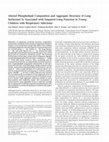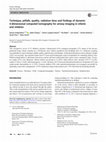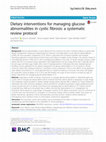Papers by Simon Langton-Hewer
The Lancet, 1996
We used a whole-gut perfusion technique to study subclinical gut inflammation in children with cy... more We used a whole-gut perfusion technique to study subclinical gut inflammation in children with cystic fibrosis (18 elective tests, three lavages to treat distal intestinal obstruction syndrome); and in 12 control children with constipation or pre-colonoscopy. We assayed for haemoglobin, IgG, albumin, alpha-1-antitrypsin, granulocyte elastase, interleukin-1 beta (IL-1 beta) and IL-8 concentrations in whole-gut lavage fluid. Results for two children with distal intestinal obstruction syndrome, the only children in the series taking Nutrizym 22, were strikingly abnormal. This new test has revealed subclinical gut mucosal inflammation in a minority of CF children, for which distal intestinal obstruction syndrome, Nutrizym 22 treatment, or both, may be risk factors.
Journal of Cystic Fibrosis, 2019

American Journal of Respiratory Cell and Molecular Biology, 2002
Alterations to pulmonary surfactant structure, composition, surfactant composition and structure ... more Alterations to pulmonary surfactant structure, composition, surfactant composition and structure may also contribute to and function contribute to the severity of respiratory infections. the etiology of other lung diseases. For instance, increased Analysis of bronchoalveolar lavage fluid (BALF) from children concentrations of plasma protein in airway fluid of patients undergoing diagnostic bronchoscopy for structural abnormaliwith acute respiratory distress syndrome (ARDS) (2) or ties (control group, n ϭ 24), asthma (n ϭ 18), lung infection asthma (3) can inhibit the surface tension-lowering abilities (n ϭ 30), and cystic fibrosis (CF, n ϭ 15) showed that BALF of lung surfactant. As the high surface pressure generated phospholipid concentration decreased with age for the control by the surfactant film in the lungs is a major force keeping group and was elevated in all disease groups. The fractional the air spaces relatively dry, such inhibition of surfactant concentration of the major surface active component, dipalmimay contribute to the severity of airway edema and mucus toyl phosphatidylcholine (PC16:0/16:0), correlated (r 2 ϭ 0.608, P Ͻ 0.01) with airway resistance (FEV 1% predicted), and de-plugging characteristic of these conditions. Similarly, hydrocreased PC16:0/16:0 was accompanied by increased concentraphilic surfactant proteins A and D (SP-A, SP-D) are integral tions of phospholipid components characteristic of cell memcomponents of the innate immune defenses of the lungs branes (PC16:0/18:1 and PI18:0/20:4). Median minimal surface against microbial lung infection (4), and decreased concentension, measured by pulsating bubble surfactometer, was eletrations of these collectin proteins may make the lungs more vated (P Ͻ 0.01) in both infection (17.5 mN/m) and CF (17.1 susceptible to infection. As antioxidant properties have re-mN/m) compared with the control group (1.5 mN/m). Centrifucently been described for SPA and, especially, SP-D (5), gation (60,000 ϫ g, 40 min) of BALF indicated that infection any decrease in their concentrations may promote oxidative was accompanied by accumulation of large aggregate forms of damage of surfactant and cell membrane phospholipid (PL). surfactant, in contrast to previous reports of increased conver-Surfactant PL itself is essentially immunosuppressive, inhibsion to inactive small aggregate surfactant particles in ventilated patients with respiratory failure. This accumulation of iting superoxide generation by granulocytes (6), cytokine surface-inactive, large aggregate forms of surfactant, possibly production by alveolar macrophages (7), and proliferation due to mixing with membrane material from inflammatory cells, of peripheral blood mononuclear cells (8). may contribute to severity of lung disease in children with respira-Altered surfactant composition of bronchoalveolar latory infections. vage fluid (BALF) or tracheal aspirates has been reported for a number of respiratory infections in children. We have Although primary surfactant deficiency is the major factor recently shown that disease progression of severe respiraunderlying the pathogenesis of neonatal respiratory distress tory syncytial virus bronchiolitis in children was accompasyndrome in preterm infants (1), secondary alterations to nied by a progressive deterioration of surfactant phospholipid composition (9), shown by a decreased fractional concentration of dipalmitoyl phosphatidylcholine (PC16:0/
The Lancet Respiratory Medicine
European Respiratory Journal

Archives of disease in childhood - Education & practice edition
A 12-month-old infant was referred with a 6-week history of recurrent admissions with worsening s... more A 12-month-old infant was referred with a 6-week history of recurrent admissions with worsening stridor. On each previous admission, the stridor responded well, but transiently, to oral dexamethasone. At this presentation, he required high-dependency unit care with high flow oxygen due to marked increased work of breathing.He was born at term, previously well, and up to date with immunisations. There was no significant family history. There were no smokers and two cats at home.He was afebrile with moderate subcostal recession and tracheal tug. On auscultation, breath sounds were normal with transmitted sounds of inspiratory and expiratory stridor. The rest of his examination was normal.He commenced dexamethasone 0.15 μg/kg three times a day, which was weaned as his clinical status improved.Blood tests showed total white cell count 9 x 10ˆ9/L, CRP <1 mg/L, lactate dehydrogenase level and blood film normal. Chest radiograph showed left lung hyperexpansion and apparent right-sided b...
The Lancet Respiratory Medicine
The Lancet Respiratory Medicine

Pediatric Radiology
This retrospective review of 33 children's dynamic 4-dimensional (4-D) computed tomography (CT) i... more This retrospective review of 33 children's dynamic 4-dimensional (4-D) computed tomography (CT) images of the airways, performed using volume scanning on a 320-detector array without anaesthesia (free-breathing) and 1.4-s continuous scanning, was undertaken to report technique, pitfalls, quality, radiation doses and findings. Tracheobronchomalacia (airway diameter collapse >28%) was recorded. Age-matched routine chest CT scans and bronchograms acted as benchmarks for comparing effective dose. Pitfalls included failure to administer intravenous contrast, pull back endotracheal tubes and/or remove nasogastric tubes. Twentytwo studies (67%) were diagnostic. Motion artefact was present in 16 (48%). Mean effective dose: dynamic 4-D CT 1.0 mSv; routine CT chest, 1.0 mSv, and bronchograms, 1.4 mSv. Dynamic 4-D CT showed tracheobronchomalacia in 20 patients (61%) and cardiovascular abnormalities in 12 (36%). Fourteen children (70%) with tracheobronchomalacia were managed successfully by optimising conservative management, 5 (25%) underwent surgical interventions and 1 (5%) died from the presenting disorder.

Systematic reviews, Jan 18, 2018
Glucose abnormalities in cystic fibrosis (CF) are common, but there is limited evidence to guide ... more Glucose abnormalities in cystic fibrosis (CF) are common, but there is limited evidence to guide their dietary management. Progressive impaired glucose tolerance eventually leads to cystic fibrosis-related diabetes (CFRD), the most prevalent complication of CF, which is associated with increased morbidity and mortality. Optimising glycaemic control improves clinical status and reduces mortality; insulin therapy is the primary means of controlling glycaemia in CFRD, but its role in managing pre-diabetes is less clear. CF dietary therapy requires a high calorie diet due to increased energy expenditure and malabsorption, but this energy-dense diet is typically high in fat and sugar, and high sugar intakes often result in hyperglycaemia in individuals who have impaired glucose handling. Current guidelines for the dietary management of glucose abnormalities in CF are based on clinical consensus rather than empirical evidence. A systematic review conducted in 2012 on the effects of low gl...
American journal of medical genetics. Part A, 2016
The cover image, by Sarah Smithson et al., is based on the Research Article Cerebro-costo-mandibu... more The cover image, by Sarah Smithson et al., is based on the Research Article Cerebro-costo-mandibular syndrome: Clinical, radiological, and genetic findings, DOI: 10.1002/ajmg.a.37587.

American journal of medical genetics. Part A, Jan 12, 2016
Cerebro-Costo-Mandibular syndrome (CCMS) is a rare autosomal dominant condition comprising branch... more Cerebro-Costo-Mandibular syndrome (CCMS) is a rare autosomal dominant condition comprising branchial arch-derivative malformations with striking rib-gaps. Affected patients often have respiratory difficulties, associated with upper airway obstruction, reduced thoracic capacity, and scoliosis. We describe a series of 12 sporadic and 4 familial patients including 13 infants/children and 3 adults. Severe micrognathia and reduced numbers of ribs with gaps are consistent findings. Cleft palate, feeding difficulties, respiratory distress, tracheostomy requirement, and scoliosis are common. Additional malformations such as horseshoe kidney, hypospadias, and septal heart defect may occur. Microcephaly and significant developmental delay are present in a small minority of patients. Key radiological findings are of a narrow thorax, multiple posterior rib gaps and abnormal costo-transverse articulation. A novel finding in 2 patients is bilateral accessory ossicles arising from the hyoid bone. ...

Journal of Evidence-Based Medicine, 2015
Lower respiratory tract infection with Pseudomonas aeruginosa (P. aeruginosa) occurs in most peop... more Lower respiratory tract infection with Pseudomonas aeruginosa (P. aeruginosa) occurs in most people with cystic fibrosis. Once chronic infection is established, P. aeruginosa is virtually impossible to eradicate and is associated with increased mortality and morbidity. Early infection may be easier to eradicate. To determine whether antibiotic treatment of early P. aeruginosa infection in children and adults with cystic fibrosis eradicates the organism and improves clinical and microbiological outcome. We searched the Cochrane Cystic Fibrosis and Genetic Disorders Group Trials Register which comprises of references identified from comprehensive electronic database searches and handsearches of relevant journals and abstract books of conference proceedings. Date of most recent search: May 2004 We included randomised controlled trials of people with cystic fibrosis, in whom P. aeruginosa had recently been isolated from respiratory secretions. We compared combinations of inhaled, oral or intravenous antibiotics with placebo or usual treatment (or both) or other combinations of inhaled, oral or intravenous antibiotics. We excluded non-randomised trials, cross-over trials, and those utilising historical controls. Both authors independently assessed selected trials, assessed methodological quality and extracted data. The search identified 15 trials. Three trials (69 participants) were eligible for inclusion. There is evidence from two randomised controlled trials, of questionable methodological quality, that treatment of early P. aeruginosa infection with inhaled tobramycin results in microbiological eradication of the organism from respiratory secretions more often than placebo and that this effect may persist for up to 12 months, however incomplete data from one of the trials precludes an accurate analysis. One randomised controlled trial of oral ciprofloxacin and nebulised colisitin versus usual treatment was identified. This trial was of poor methodological quality. The results suggested treatment of early infection results in microbiological eradication of P. aeruginosa more often than usual treatment, after two years, RR 0.24 (95% CI 0.06 to 0.96). There is insufficient evidence to determine whether antibiotic strategies for the eradication of early P. aeruginosa decrease mortality or morbidity, improve quality of life, or are associated with adverse effects compared to placebo or standard treatment. From the three trials included in this review, there is some evidence that antibiotic treatment of early P. aeruginosa results in short-term eradication but it remains uncertain whether there is clinical benefit to people with cystic fibrosis.
http://isrctn.org/>, 2000

Reviews, 1996
Lower respiratory tract infection with Pseudomonas aeruginosa (P. aeruginosa) occurs in most peop... more Lower respiratory tract infection with Pseudomonas aeruginosa (P. aeruginosa) occurs in most people with cystic fibrosis. Once chronic infection is established, P. aeruginosa is virtually impossible to eradicate and is associated with increased mortality and morbidity. Early infection may be easier to eradicate. To determine whether antibiotic treatment of early P. aeruginosa infection in children and adults with cystic fibrosis eradicates the organism and improves clinical and microbiological outcome. We searched the Cochrane Cystic Fibrosis and Genetic Disorders Group Trials Register which comprises of references identified from comprehensive electronic database searches and handsearches of relevant journals and abstract books of conference proceedings. Date of most recent search: May 2004 We included randomised controlled trials of people with cystic fibrosis, in whom P. aeruginosa had recently been isolated from respiratory secretions. We compared combinations of inhaled, oral or intravenous antibiotics with placebo or usual treatment (or both) or other combinations of inhaled, oral or intravenous antibiotics. We excluded non-randomised trials, cross-over trials, and those utilising historical controls. Both authors independently assessed selected trials, assessed methodological quality and extracted data. The search identified 15 trials. Three trials (69 participants) were eligible for inclusion. There is evidence from two randomised controlled trials, of questionable methodological quality, that treatment of early P. aeruginosa infection with inhaled tobramycin results in microbiological eradication of the organism from respiratory secretions more often than placebo and that this effect may persist for up to 12 months, however incomplete data from one of the trials precludes an accurate analysis. One randomised controlled trial of oral ciprofloxacin and nebulised colisitin versus usual treatment was identified. This trial was of poor methodological quality. The results suggested treatment of early infection results in microbiological eradication of P. aeruginosa more often than usual treatment, after two years, RR 0.24 (95% CI 0.06 to 0.96). There is insufficient evidence to determine whether antibiotic strategies for the eradication of early P. aeruginosa decrease mortality or morbidity, improve quality of life, or are associated with adverse effects compared to placebo or standard treatment. From the three trials included in this review, there is some evidence that antibiotic treatment of early P. aeruginosa results in short-term eradication but it remains uncertain whether there is clinical benefit to people with cystic fibrosis.








Uploads
Papers by Simon Langton-Hewer